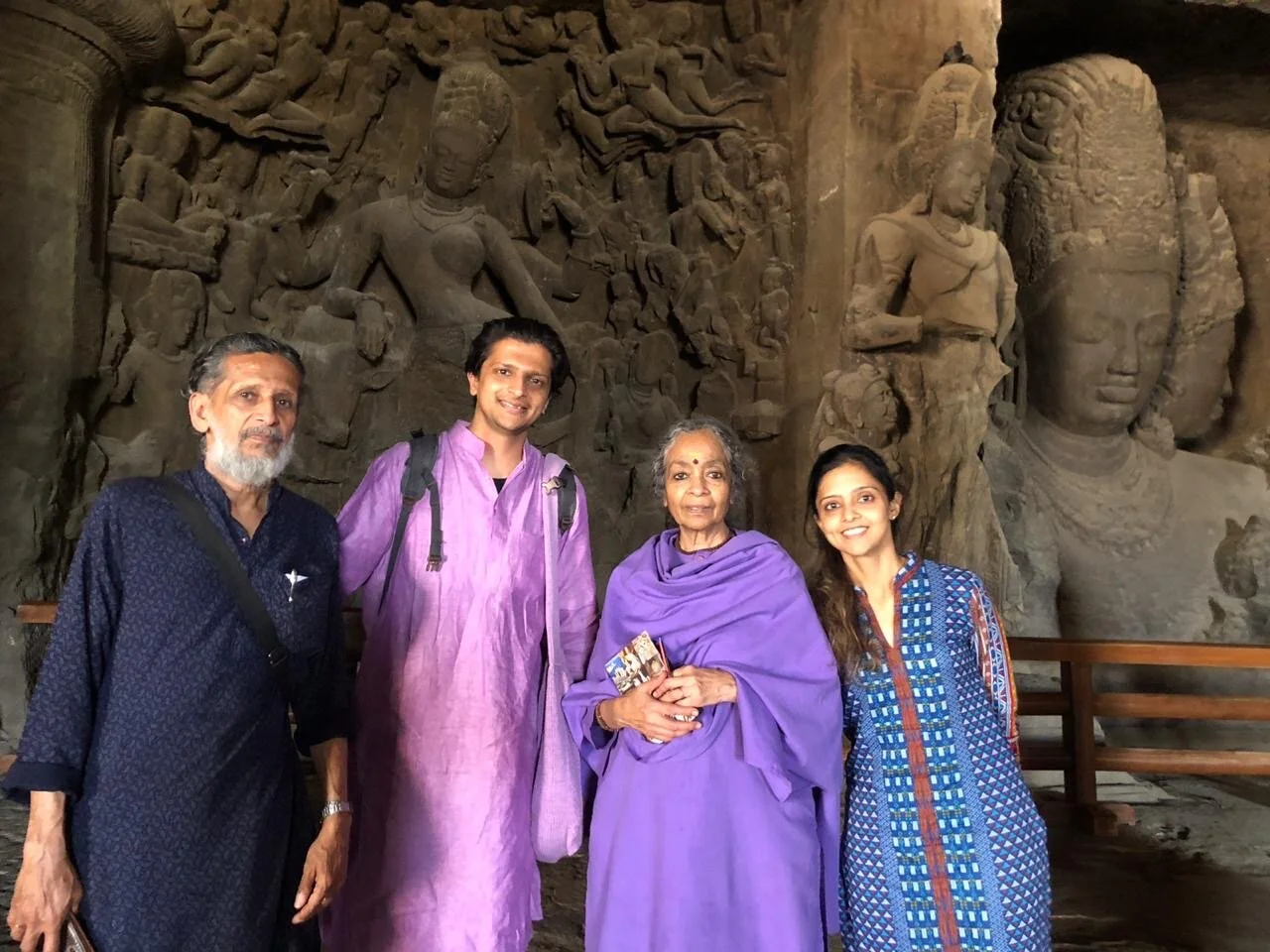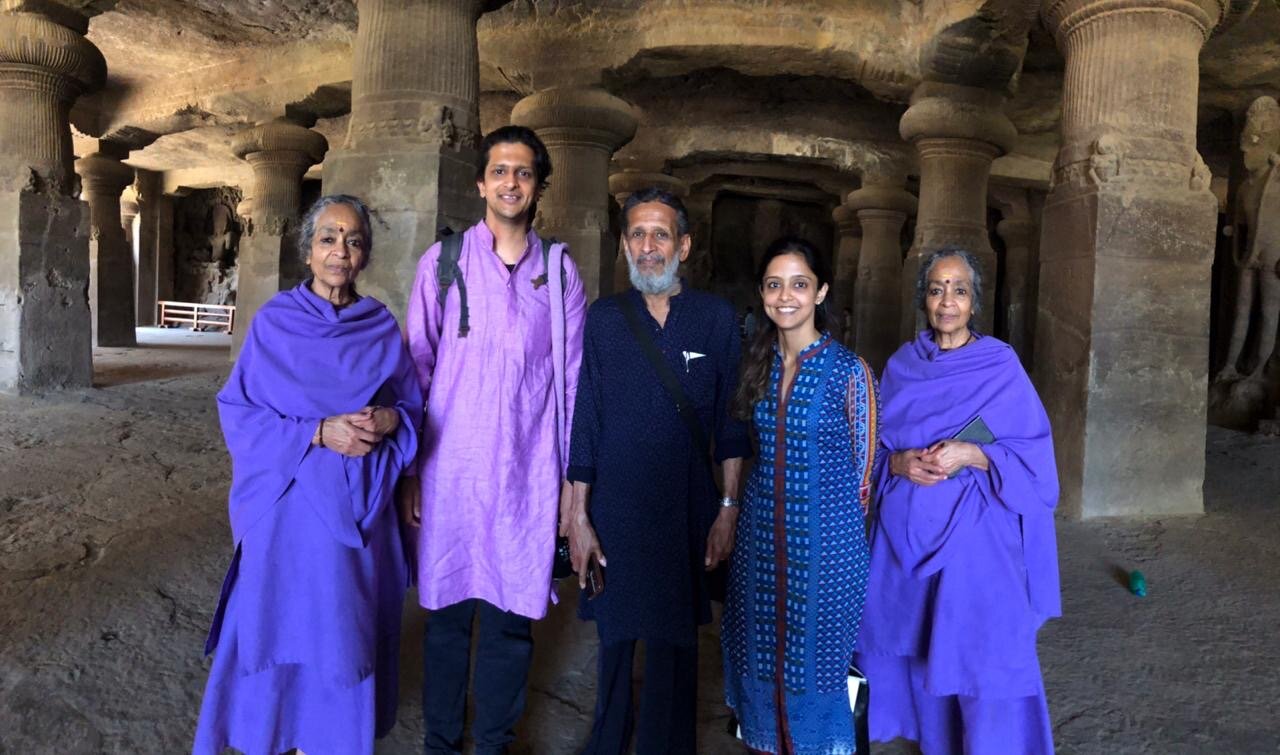Visit to Elephanta Caves
Strangely enough my desire to go to the Elephanta Caves was fulfilled just before the lockdown caused by the pandemic. Though the place is only ten kilometres from Mumbai Harbour, our friends who were born and brought up in Mumbai had never been there! This is a typical failing in most affluent Indians. They prefer to go on a holiday abroad and will rave about the caves and other wonderful things they have seen in Europe or America but are too lazy to make a trip to the incredible places that India is flooded with. Our education is also partly to blame since we are never taught about the greatness of our culture but only about the greatness of the culture of our conquerors!
The ferry ride to the island set the tone for the whole trip. Gulls came screaming and swooping on us as the boat bounced through the frothy waves. The ocean was generous with her salt water and sprayed it lavishly on us. When we got down we were offered a ride in a mini train to the nearest point where the climb to the caves started.
We had resisted every attempt by eager guides to accompany us but were cornered right in front of the first cave by someone who claimed to be a long-term resident of this island which is actually known as Gharapuri – the city of caves. The name Elephanta Caves was given by the Portuguese invaders who discovered a huge figure of a black stone elephant as soon as they landed on the island. The figure was badly damaged and later when the British occupied the island they had it removed and kept outside the Dr. Bhau Daji Lad museum on the mainland, where it remains to this day. It must have been quite a feat to have removed it.
Who were these people who had created these fantastic structures I wondered? Local legends claim they were made by non-human agencies whereas the earliest records identify the island as Purika, the capital of the Konkan Maurya kingdom in the 6th century C.E . Apparently the island had been occupied from 2nd century BC and the sculptures were done from about mid- 5th to 8th centuries AD.
The first thing that strikes you as you enter the first cave is the size. One can’t imagine such enormous caves. The other thing that strikes you is the sheer dimension of each of these sculptures, which must have taken months or even years of dedicated labour to complete. Who were these people who had undertaken such a laborious job? What utter devotional fervour propelled them to undertake such fantastic feats?
The guide told us that these caves were the most magnificent in the history of rock architecture in western India. I could well believe it. They were certainly unique creations. However the Portuguese did insufferable damage to them. These glorious figures had even been used for target practice by the soldiers! Evidence of this can be seen by the bullet holes in some of them. However I suppose one can only be grateful that at least something remains to tell the tale of a glorious past. Since I had been to Ellora recently I was struck by their resemblance to the cave sculptures there.
The sculptures were supposedly built between the 5th and 8th century C.E. They had survived through centuries of human habitation, invasion and neglect only because they were carved out of hard rock! Despite the fact that so many of them had been defaced beyond recognition, what remains is so enthralling that I could well imagine their grandeur at the time of construction. Thankfully the Great Cave is the one that has been best preserved. Apparently it was a temple and was an active place of worship for the Hindu residents of the island until the 1500s, when the Portuguese took over. In the middle of the cave is the huge lingam which is still being worshipped. The fifteen large reliefs surrounding the lingam shrine not only constitute the greatest examples of Indian art but also some of the most important collections for the worship of Shiva.
As we entered the Great Cave what struck me was the gigantic figure facing us right at the back of the cave. It was the enormous three-faced form whose photo is displayed in airports, stations and guide books. I was all set to go towards it but our enthusiastic tour guide insisted we take the normal route starting with the Nataraja on our right.
Nataraja
What is shocking in all the sculptures is the callousness of the Portuguese soldiers who had tried their best to mutilate these awe- inspiring figures. How could anyone have had the heart to do this I wondered? What sort of barbarians were they who had absolutely no concept of beauty or compassion! How could they have had the heart to destroy these figures of such exquisite beauty and grandeur?
The first form on the right was Shiva Nataraja – the dancing Shiva. It must have had eight hands but now only three remain. The left leg had been totally chopped off and right leg cut off at the knee. It was so distressing to see such things. Thankfully the beautiful serene face was still intact. To his right is a perfect figure of Ganesha and another less perfect one of Kartikeya, both of who are Shiva’s sons. Above them is Brahma and on the other side are Parvati , Vishnu and Indra, king of gods and some smaller figures which are difficult to decipher. Every one of these figures however small was carved beautifully with such attention to every detail. This was true of all the sculptures.
Andhakasuravadha
The next huge sculpture is that of Shiva as Andhakasura, the killer of the demon called Andhaka. The astonishing thing about all these figures is their sheer size. This one must be about 12 feet. Shiva’s face here is fierce. The jaws are grim and the molars project outwards. His eyes seem to be swollen with rage. Hanging down from the left shoulders up to the thigh is a gruesome looking garland of skulls. He has eight arms out of which five have been mutilated. His legs have been cut off. One hand holds a trisul (trident) and the other a bell.
How had these ancient artists carved these huge figures I wondered. Did they stand on ladders and hack away. What sort of instruments did they use? How did they keep these perfect proportions without the use of modern instrumentation? It was certainly a mystery! We see this same artistic perfection and mystery in the Ellora caves which makes me believe that the same artisans had done this.
Lingam
Almost in front of this is the shrine with the big lingam. A lingam is the elliptical form of Shiva. The shrine has four doors opening out in all four directions. Each door has two hefty doorkeepers or dwarapalas standing on either side. This must have been the actual temple built to the right side of the cave and the other figures all round it must have been made as embellishments. The lingam had not been cut out of the rock but had been made separately and fitted into a hole in the pedestal on which it stands. Apparently the villagers still worship at this shrine. I could see fresh flowers and bel (trefoil) leaves that might have been offered that very morning. The guide said that Shivaratri is still conducted here on a large scale. This means that it must have been worshipped from the 2nd century onwards since the island had been inhabited from that time. You really feel that in India time has no meaning. The river of time has been flowing from eternity to eternity. We are only a few drops somewhere along the line. How insignificant it makes you feel!
There is a courtyard below this on the right on which the remains of a dilapidated platform can be seen. This must have held the figure of Nandi who is ever on guard in front of any Shiva temple. Sadly enough nothing remains of this.
Kalyana Sundamurti
The next figure as we continue our tour is a most beautiful one - the marriage of Shiva and Parvati. Shiva’s facial expression is in sharp contrast to the one in which he is killing the asura, Andhaka. However the whole thing is so mutilated that I really felt like crying, not just for the destruction of such beauty but for the nature of the human beasts who could indulge is such wanton destruction. Of course in India we are used to seeing this in all our great temples that have been ruthlessly destroyed by Aurangzeb and others of his clan starting from Muhammed Ghazni.
Shiva is smiling and has a halo round him. His hair is in the usual “jatamukuta” in which the crown is made up of his matted hair. His right arm is extended to receive Parvati’s hand but of course it is broken. Parvati is on his right since she has not yet been wed. Once she becomes a wife she would be placed on his left. Her legs and arms are totally disfigured but her face is still beautiful with little curls hanging in ringlets. She is adorned with ear-rings and necklaces. She has a bashful look. The man behind her is probably her father –Himavan, King of the Himalayas. The defaced figure to the left of Shiva may be that of Brahma who is supposed to be the priest who officiated at the marriage. Above that is probably Vishnu since he is holding something like a chakra or wheel, which is his weapon.
Gangadharamurti
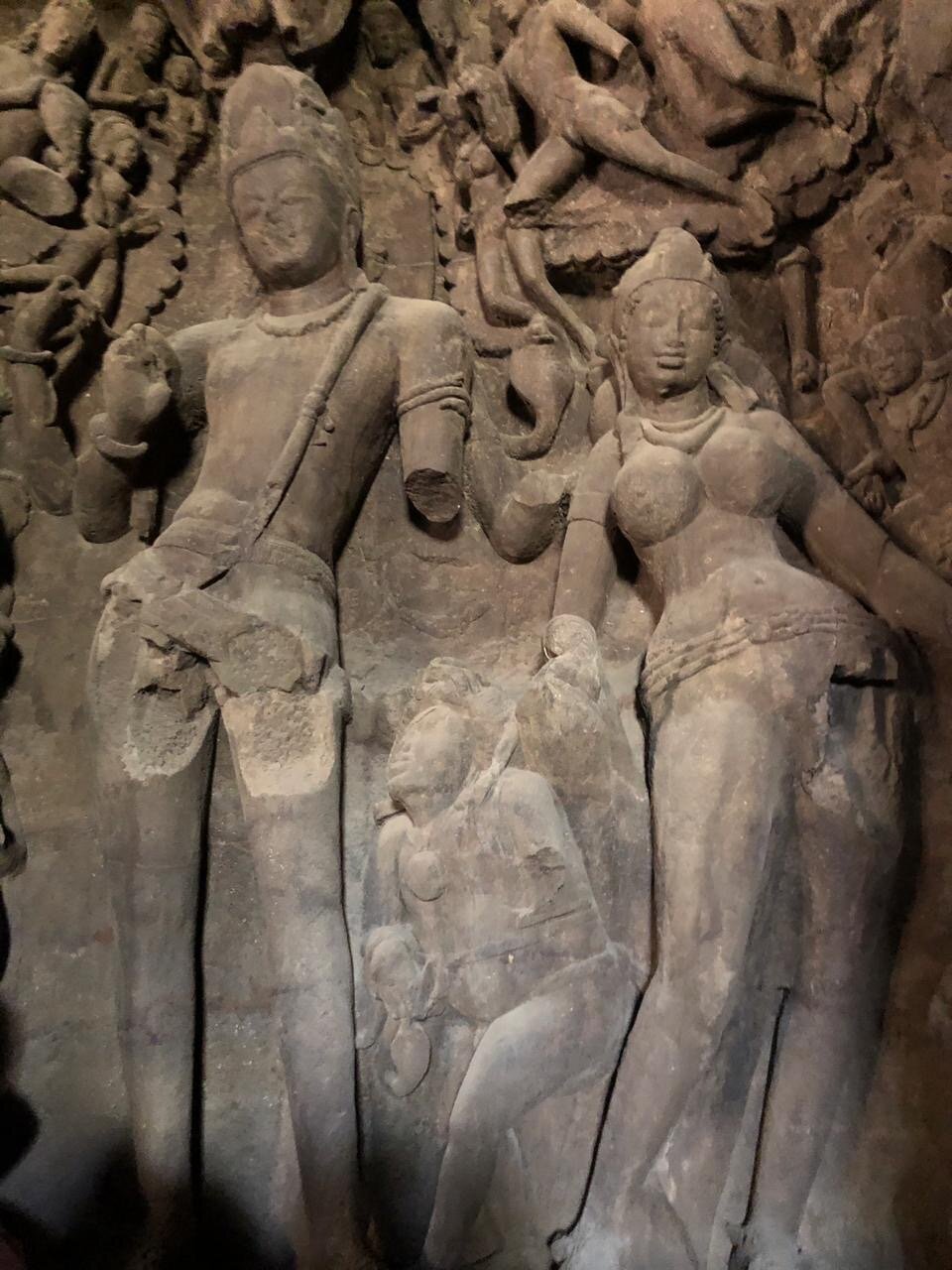

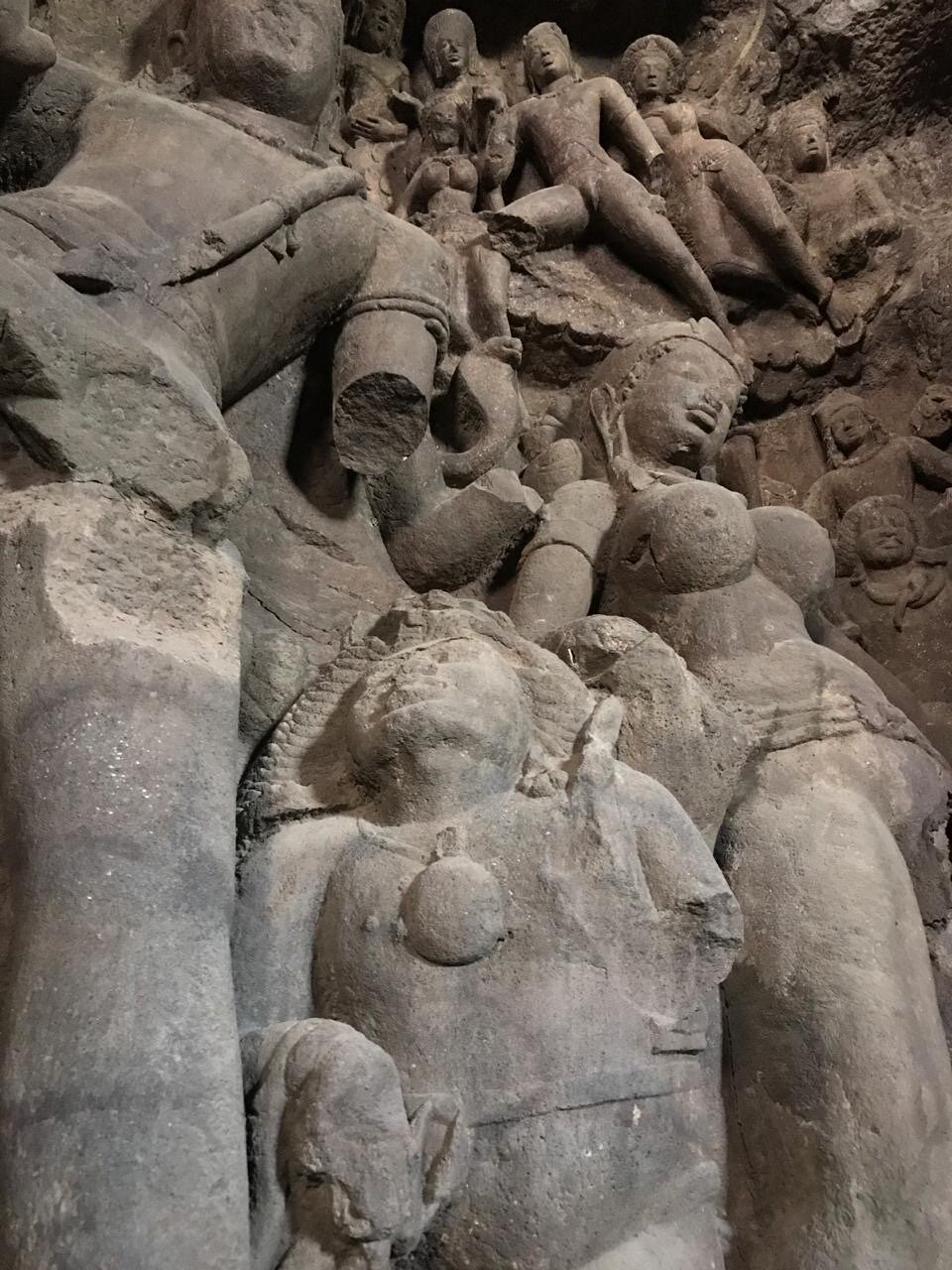
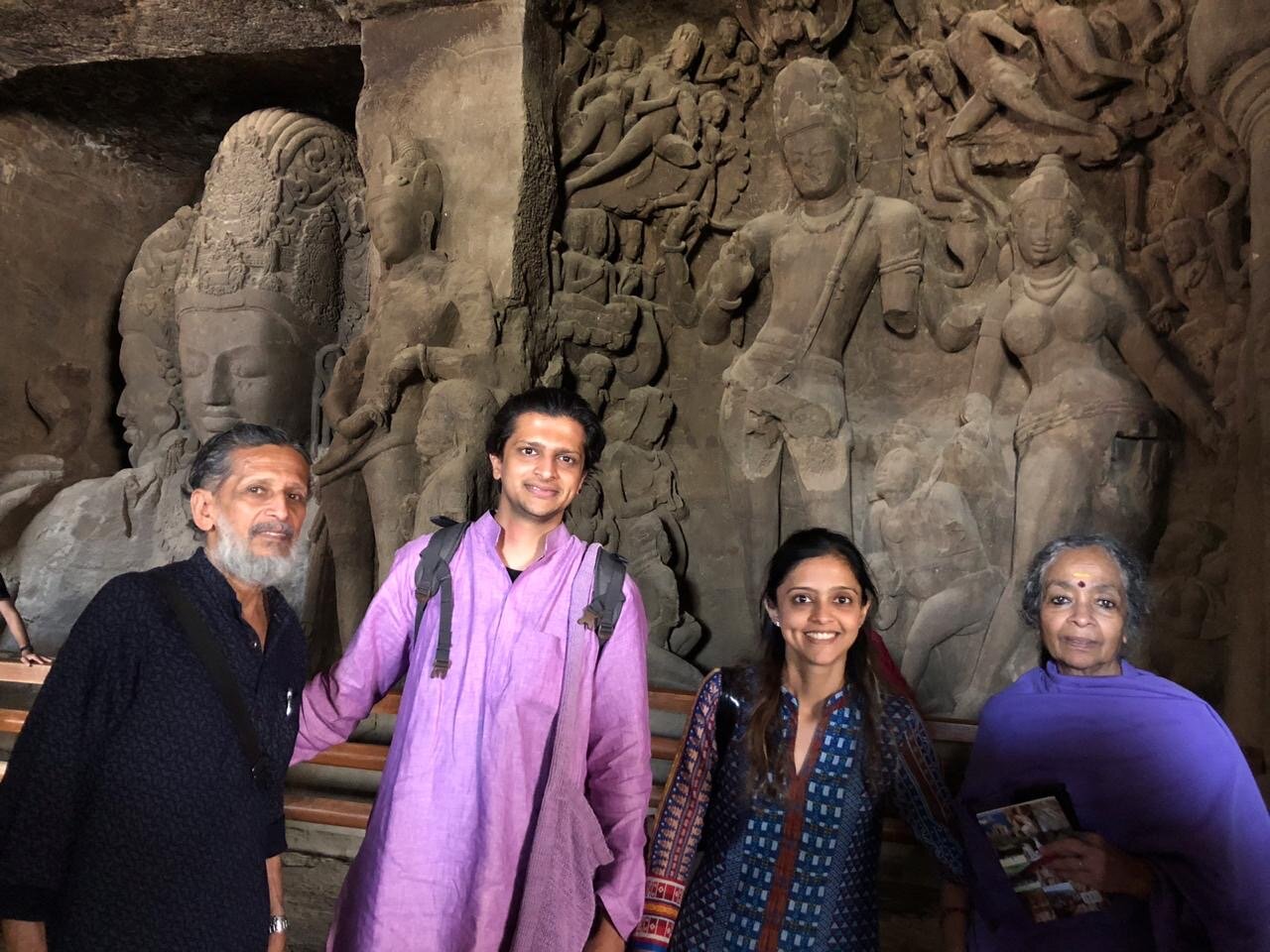
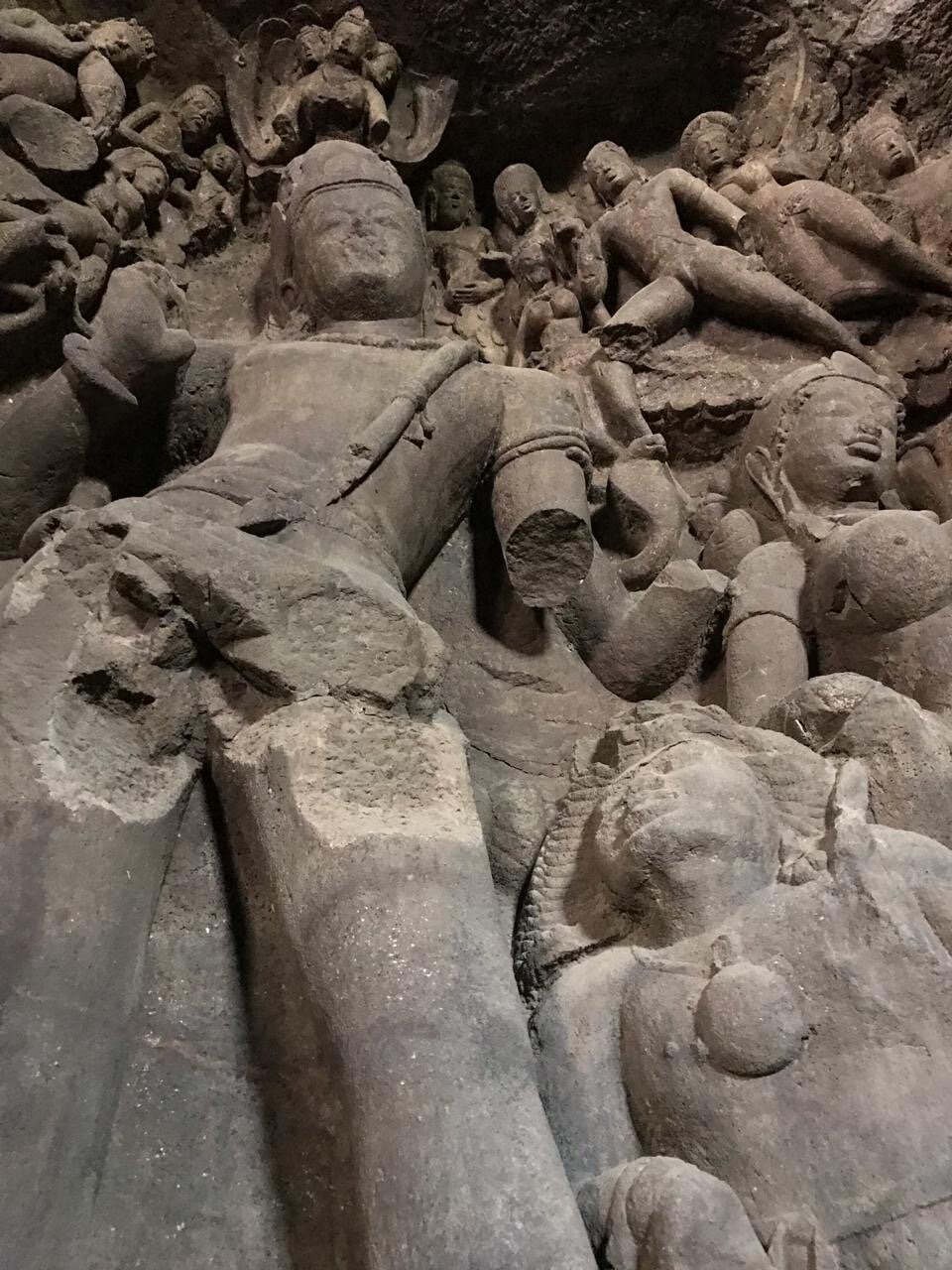
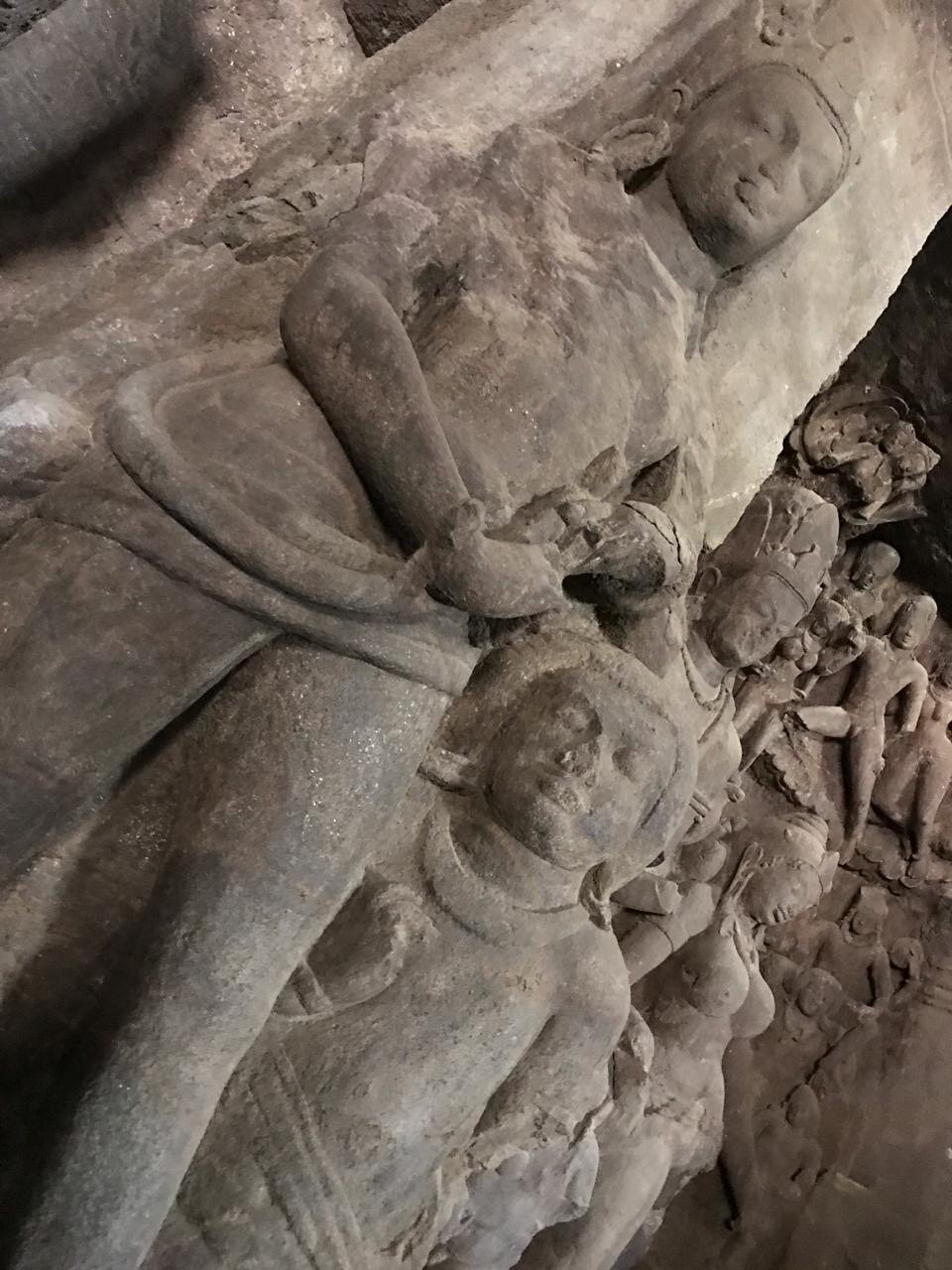
The next panel is that of Gangadhara – Shiva carrying the Ganga. This has reference to the story of King Bhagiratha who begged Shiva to catch the celestial river Ganga in his matted locks in order to break her fall. In this sculpture, Parvati stands to his left as befitting a wife. Near Parvati’s shoulder is Vishnu on his eagle vehicle – Garuda. Above Shiva’s right shoulder is Brahma on his lotus seat carried by swans. There is a three-headed female figure right on top which according to our guide represents the Triveni Sangam in Prayag- Raj (Allahabad) of the rivers, Ganga, Yamuna and Saraswati.
Sadashiva
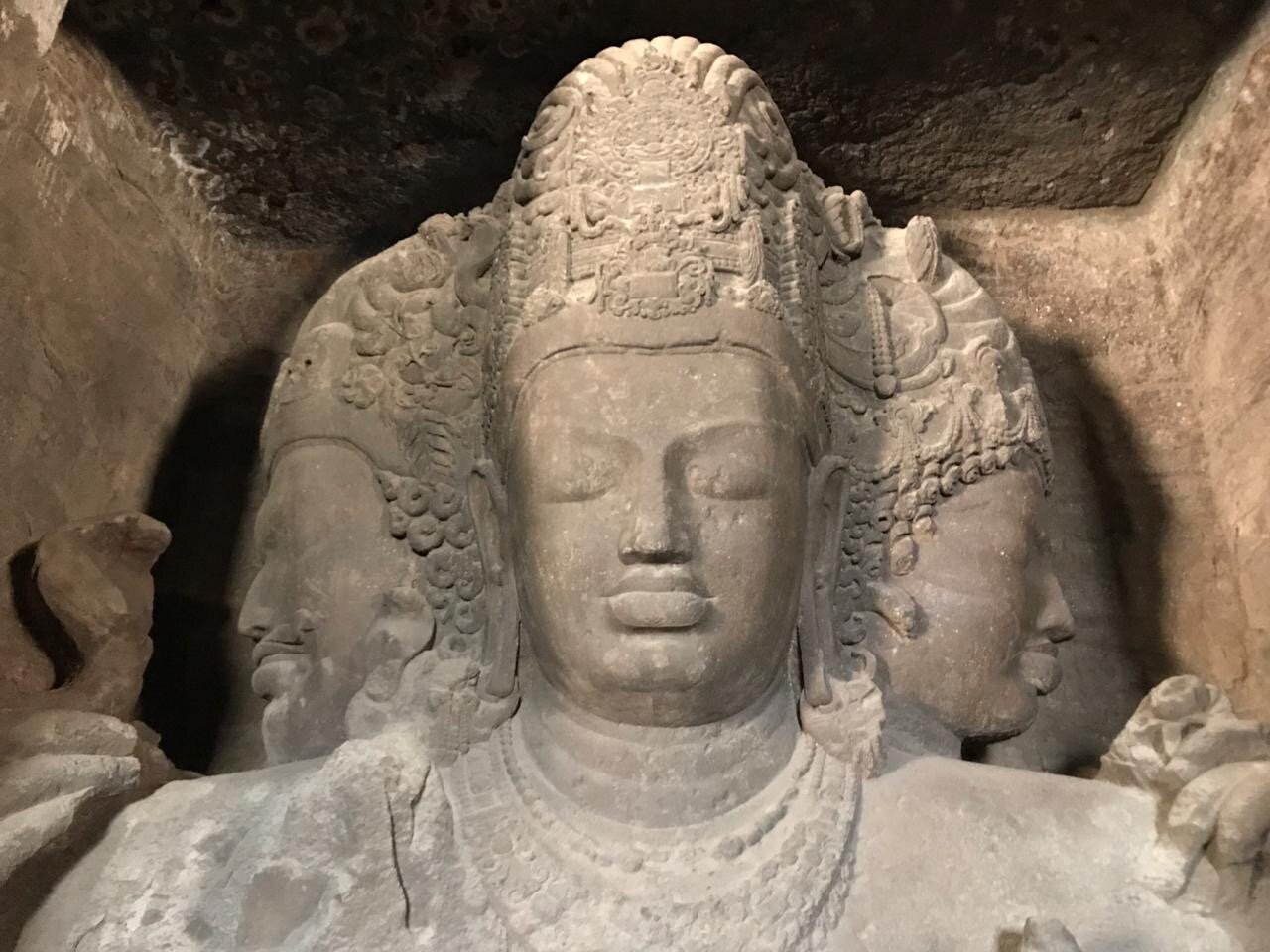
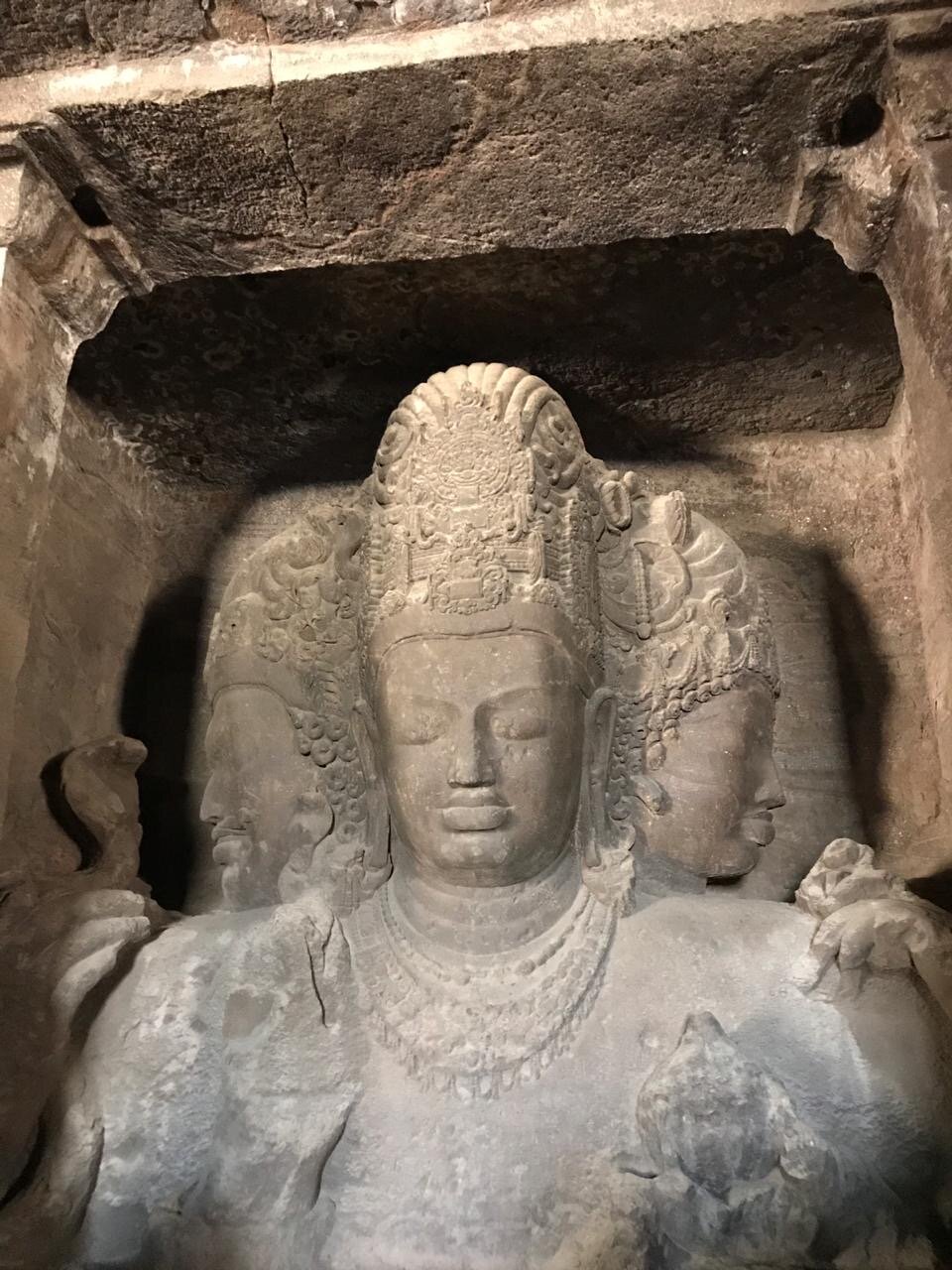
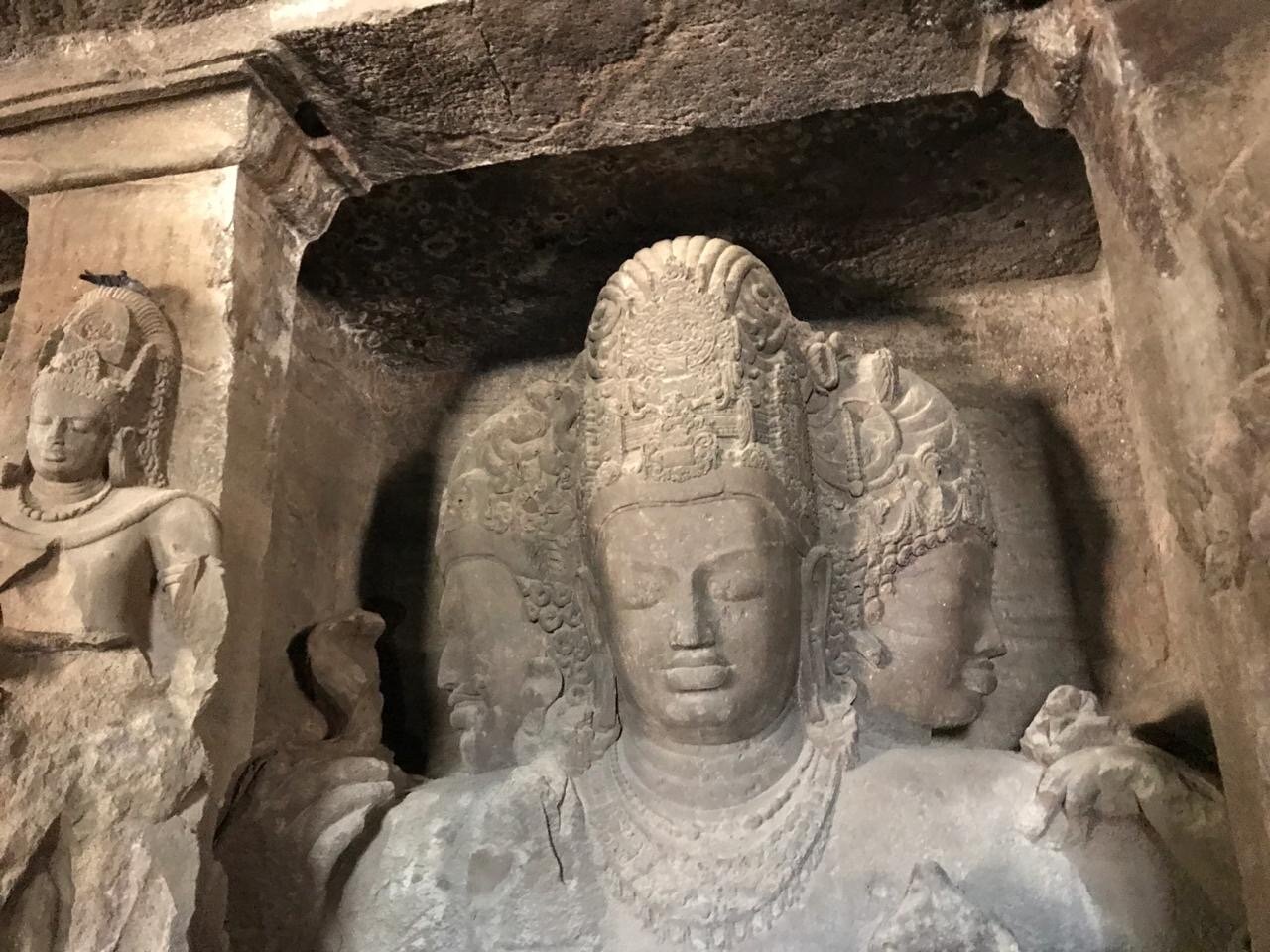
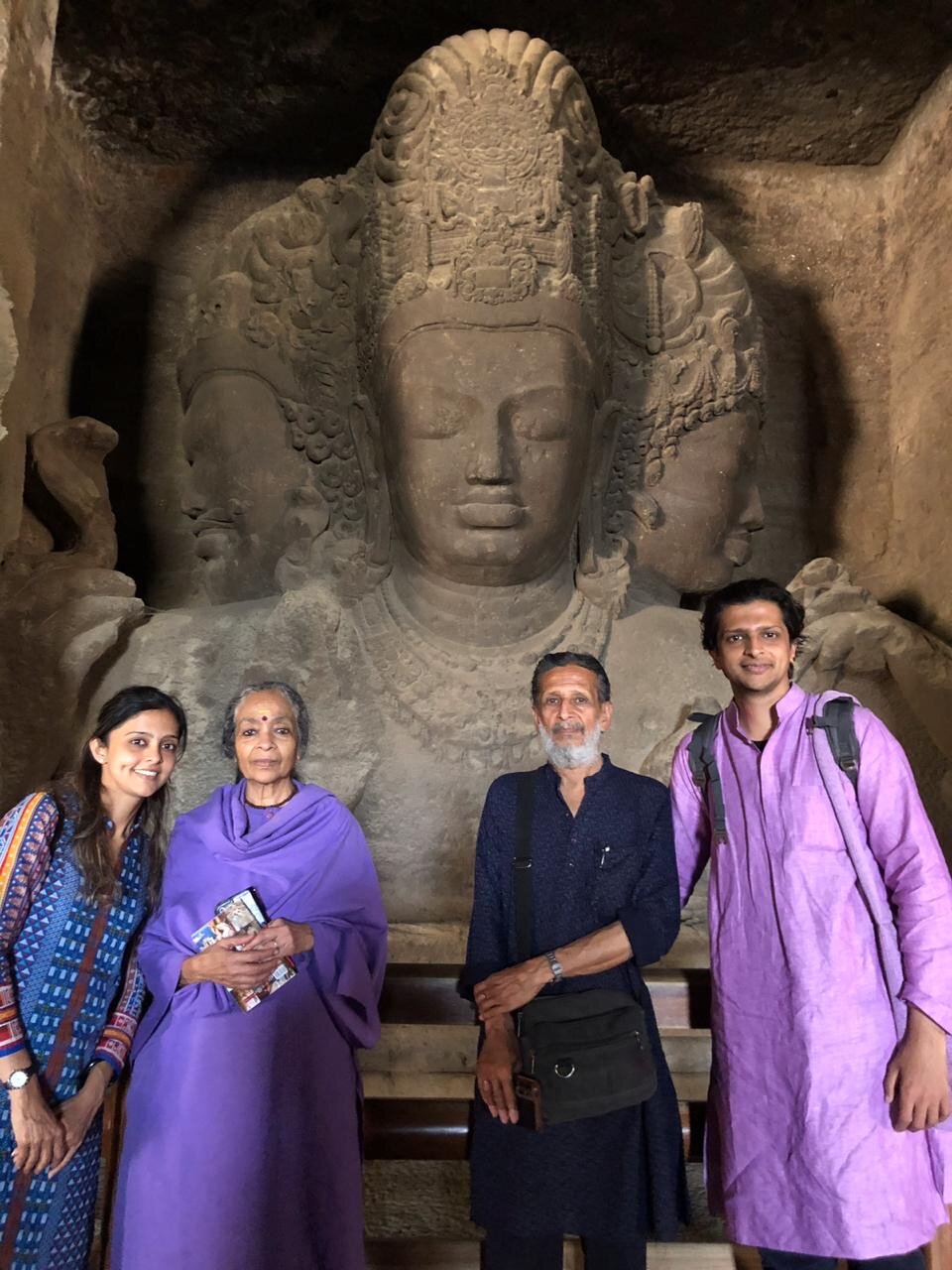
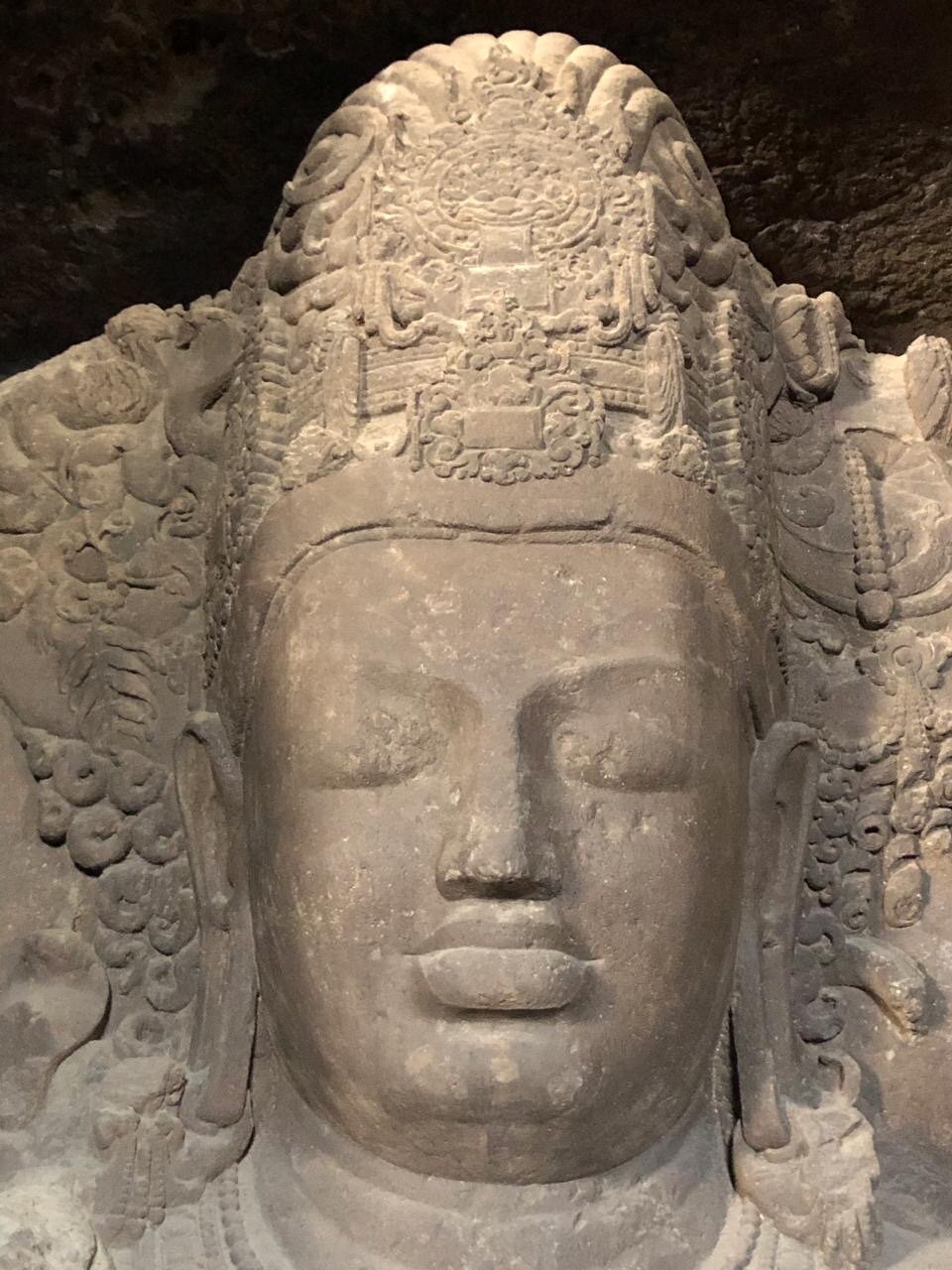
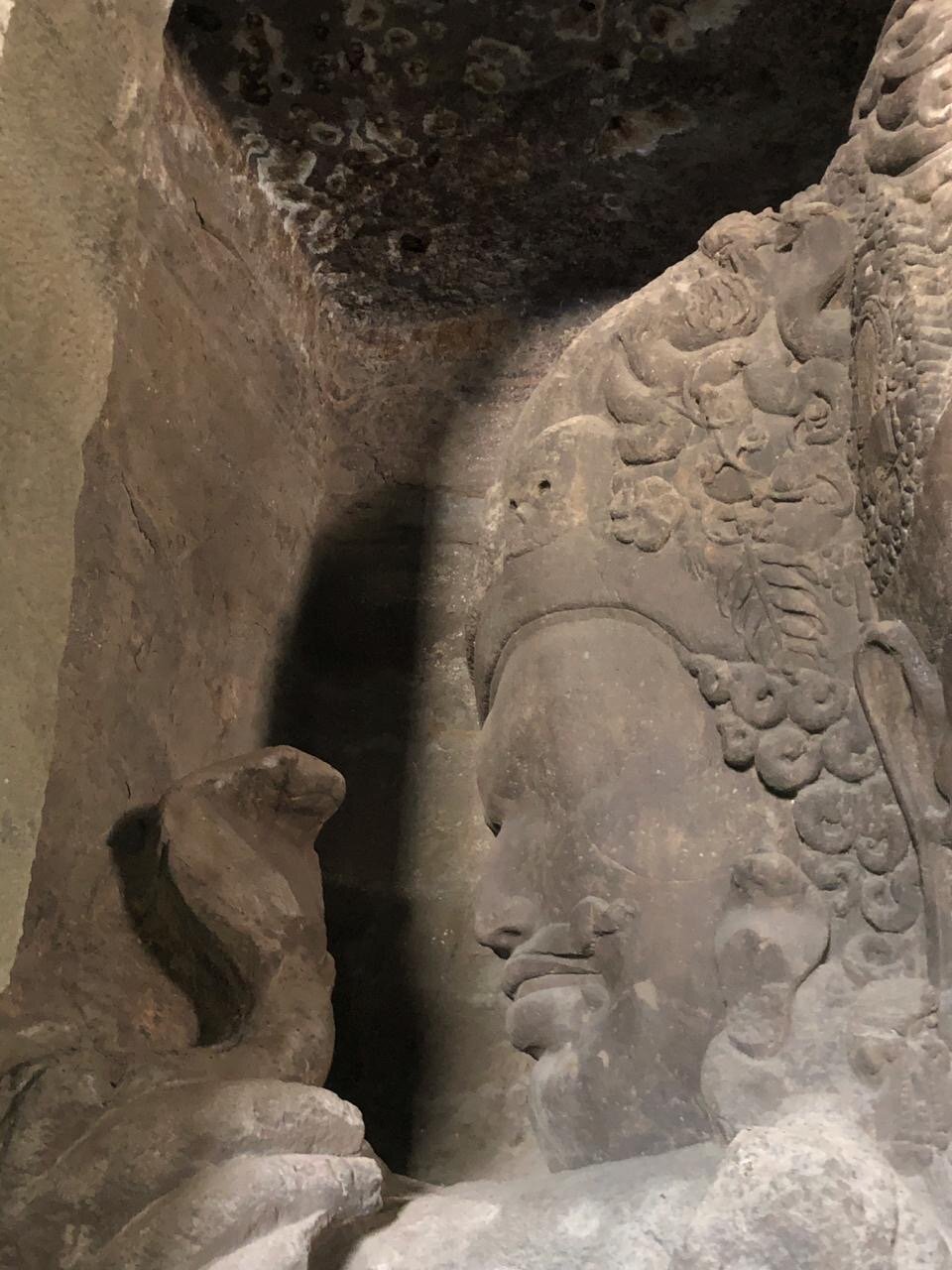
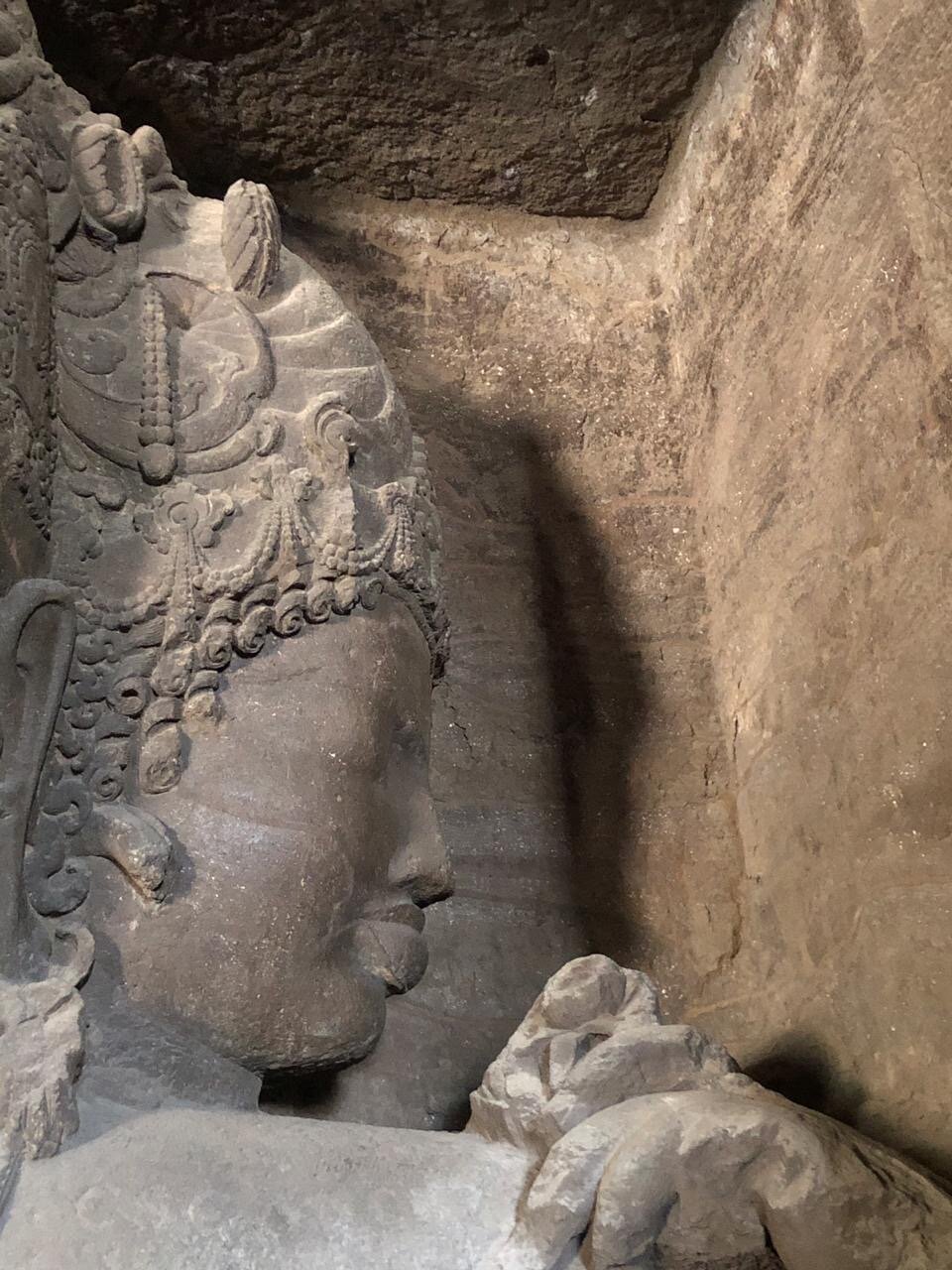
The next alcove takes you to the famous pictorial representation of Elephanta Caves which is the ginormous three faces of Shiva which strike you as you enter the cave at the very beginning. The 7-metre-high masterpiece “Sadashiva” dominates the entrance to Cave 1.
This surely is the most striking of all the sculptures. It has been wrongly said to be the picturization of the Hindu trinity – Brahma, Vishnu and Shiva but this is not true. This is Sadashiva – Shiva as the great Lord of the universe who has all the three functions of creation, protection and destruction. All three faces represent Shiva. The sculptor has represented the three aspects of Shiva as the Creator, the Preserver, and the Destroyer, identified, respectively, with Aghora or Bhairava on the left, Tatpurusha or Mahadeva in the centre and Vamadeva on the right.
The Supreme, Maheswara takes on different forms and names depending on the function he is performing.
The face in front is very calm and dignified and here Shiva is in the role of the Creator. The jataor matted hair placed in a crown has the crescent moon on the right side. He wears a sort of tiara and his ears have the makara kundala or fish-shaped earrings. The right hand is totally mutilated.
The face to our left is the terrifying face of Rudra, Aghora- the destroyer. He has a curling moustache and beard. His clothing is crawling with snakes and the right hand holds a cobra twisted round the wrist.
The face to our right represents Shiva as the preserver. He has a very calm and benign expression. The ears have conch -like earrings. The hair falls in ringlets from beneath the head dress. The left hand holds a lotus. I was quite mesmerised by the characterisation here and stood for a long while taking in the aspect of the Supreme as everything. Hinduism is the only religion that claims that all duality comes from the Supreme – He is creator and destroyer, preserver and enjoyer – the object as well as the supreme subject. Our culture never created a separate cruel being like the devil who was the cause of all evil. There is only one energy- one source, for everything.
Ardhanarishwara
The next panel is of Shiva as Ardhanarishwara – Shiva in his form as half male and half female. It’s a very striking figure. This again is peculiar to Hinduism – the fact that God has no sex and can be considered to be both male and female. This figure is a graphic representation of this idea. One right hand is kept lovingly on Nandi – his bull vehicle. The hair on the left side of the head is dressed in a very elaborate fashion and has a sort of veil hanging down as befitting a female while the right side is adorned with the crescent moon which is the usual adornment we expect for Shiva. The right side is the male side so the ear is pulled down and has a ring in it. The male arms wear twisted armlets and thick wristlets. The female arms on the left have solid bracelets with thick jewelled rings at the ends. Thankfully the back pair of hands is well preserved and the right hand holds a cobra and the left a mirror. The hair style on the left has hair falling in cute ringlets. Of course the female side depicts Parvati.
As usual with all the sculptures other gods are also shown. Vishnu astride the Garuda is shown on the left above Parvati and on the right side are Indra and Brahma. Brahma is seated on a lotus supported by five swans. Fortunately three of his faces are seen. Of course his fourth face is at the back so we can never see it. To his left is Indra, king of the gods, seated on Airavata his elephant vehicle. Some of the figures carry garlands no doubt as offerings to Ardhanariswara.
Uma Maheshwara
The next panel is unfortunately one of the most damaged. It is called Uma Maheswara and has both Shiva and Parvati, adorned with the usual ornaments sitting on a raised platform probably playing dice but very little remains. Shiva is almost totally damaged. Parvati seems to be in a half sitting posture as if she is preparing to get on Nandi the bull who is seated directly below her.
Ravananugrahamurti
Ravana, king of Lanka had wrested the celestial car called Pushpaka from his brother Kubera. Once while he was flying close to Kailasa, the abode of Shiva, he was arrested by Nandi who told him that he could not proceed that way since Shiva was sporting there. (Violation of air space!!) Ravana called him a monkey and contemptuously told him to clear off as he had no idea who this Shiva was. Nandi cursed him and said that one day he would be destroyed by the very race of the monkeys who he despised. Ravana was incensed and told him that he would uproot the mountain and throw it out of his way. He got off the vimana (aerial vehicle) and put his arms under the mountain and started to lift it. Parvati was terrified at the seeming earthquake and clung to Shiva. The Lord said nothing but pressed his left toe down and crushed Ravana’s arms. Ravana howled in pain and his grandfather Pulastya came and warned him of the consequences of displeasing the great Lord and asked him to praise Shiva. Ravana did so and composed the famous Shiva Tandava Stotra. Shiva removed his toe and released Ravana.
This panel shows this scene in which Shiva and Parvati are seated together. All their arms are broken and Parvati’s figure is badly destroyed. Around him are his attendants and Ganesha. Below the group is the ten-headed figure of Ravana with his back turned towards us. All his heads have been chopped off and only a few of his twenty arms are left.
Yogeeswara
This is the last of the series in this cave. The Lord sits cross-egged in padmasana (lotus posture) and is dressed as befitting a yogi. The lotus on which he is sitting is being held up by two nagas(snake gods) on either side. You can see that the face has a placid expression even though it’s badly damaged. The arms are totally destroyed from the shoulders. Celestials can be noticed flying above his head. Brahma and Indra are shown on the right. On each side there is a female attendant holding a chamara or yak tail whisk. To the left is a banana tree and beneath that Vishnu on the Garuda. But the whole effect which should have given such a peaceful effect on the viewers is spoilt by the wanton destruction.
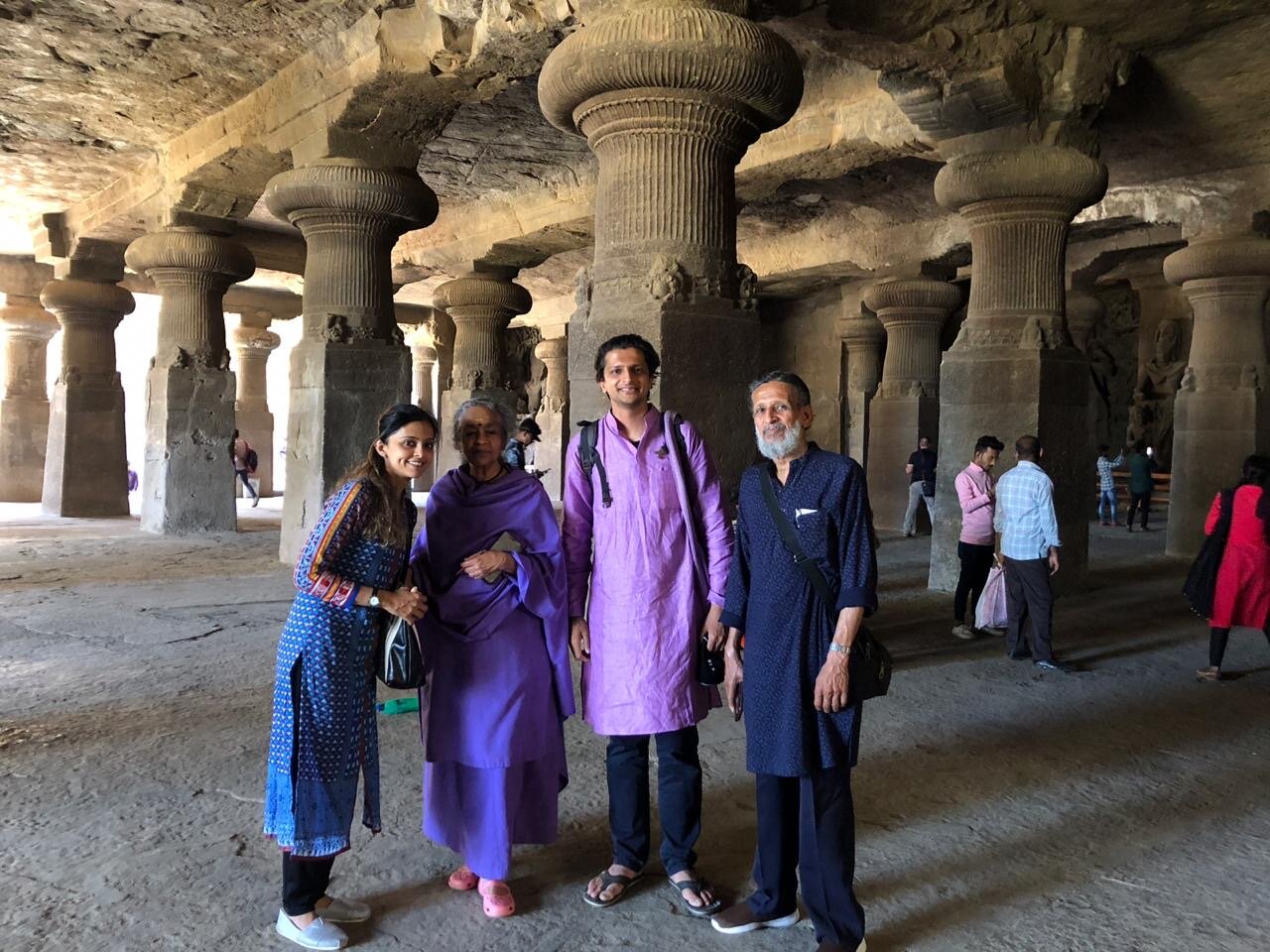
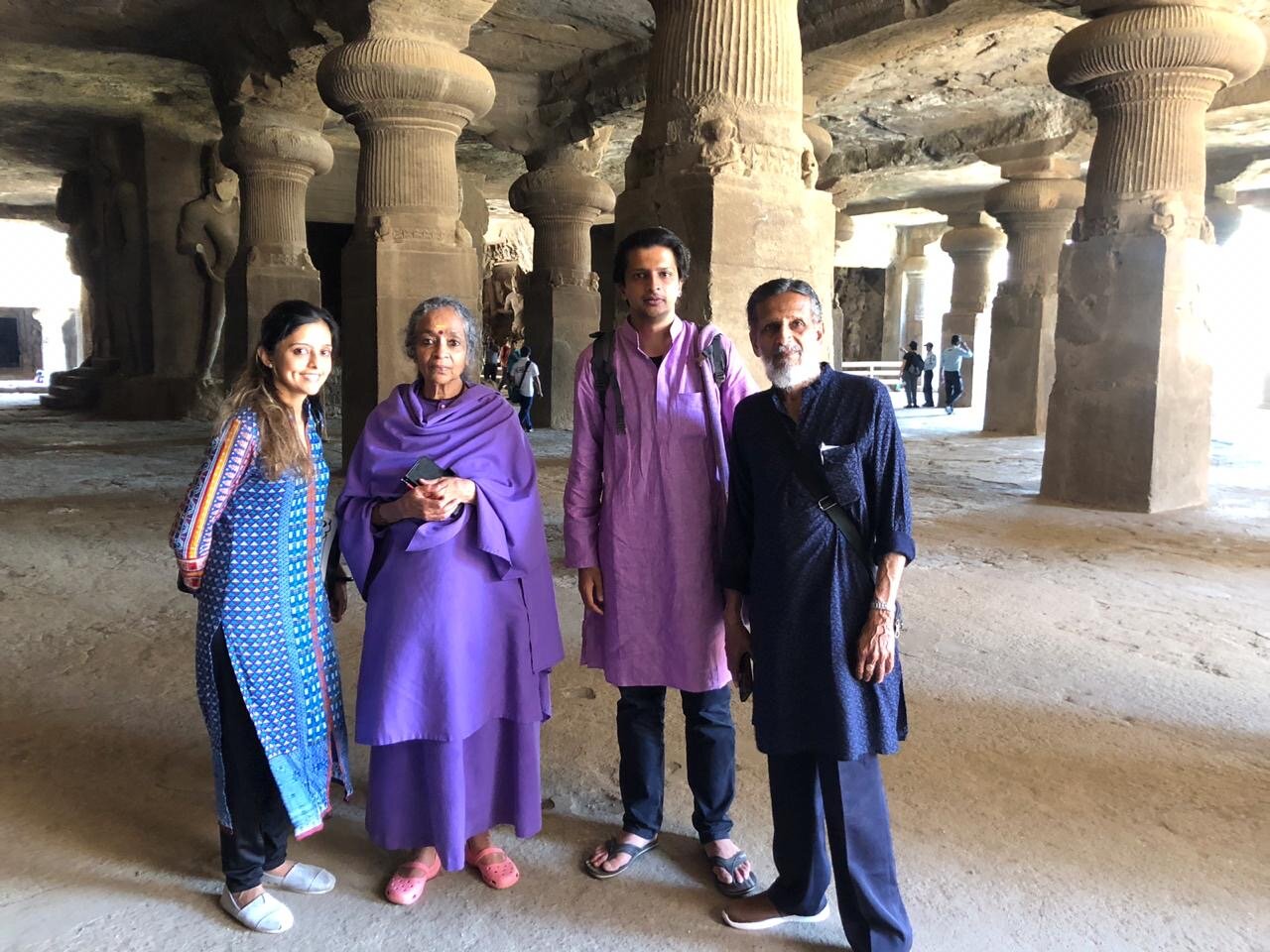
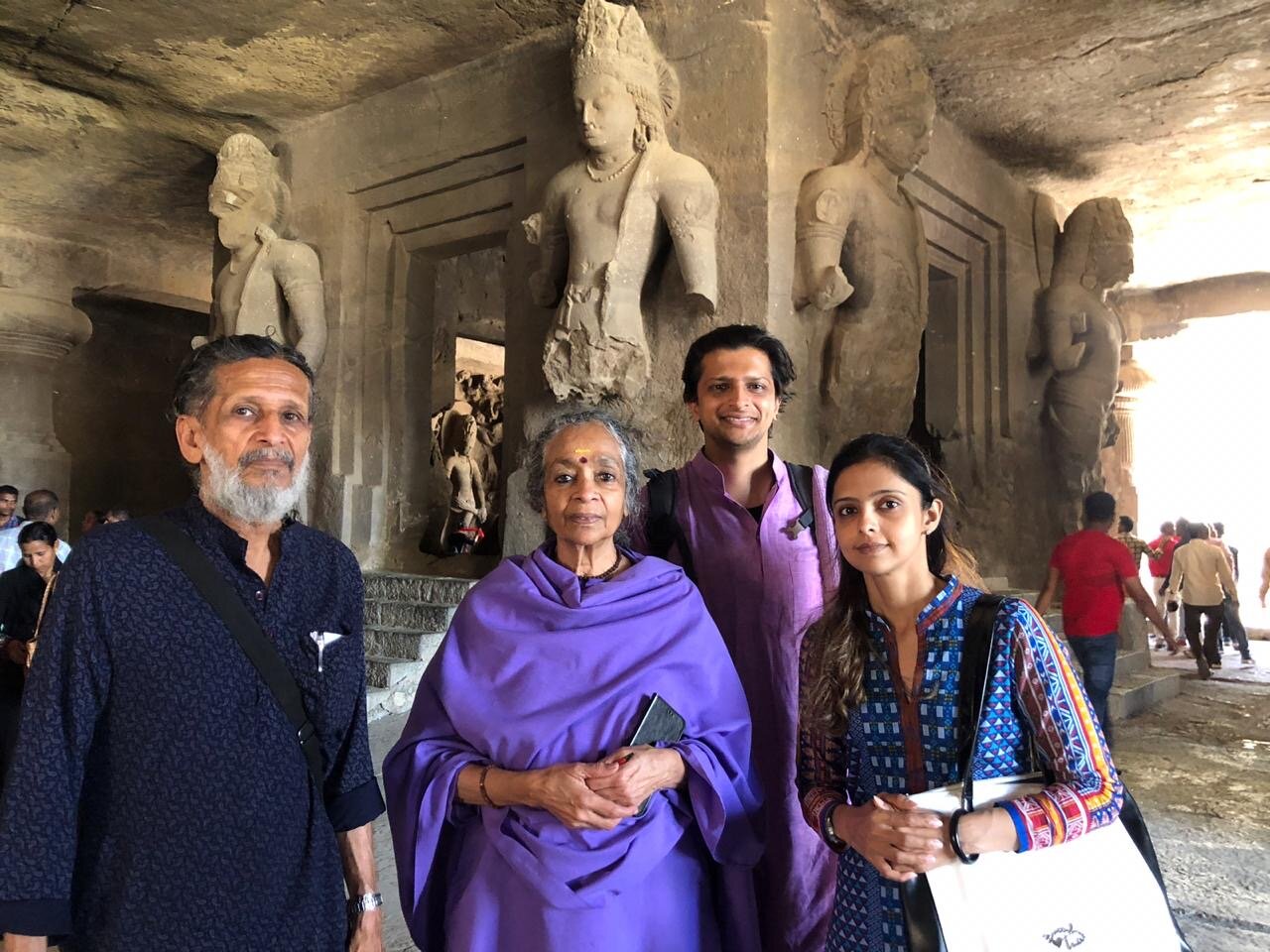
We came out of the great cave to the left into a courtyard to the next set of sculptures. This has remained fairly intact in comparison to the other dilapidated caves. It is known as the Sitabai Temple and is actually a large prayer hall with walls adorned with rich and intricate sculptures. This completed our tour of the caves. Of course the island has many other things of interest to tourists but it was getting very hot so we decided to return.
Our guide who had become a friend had been a professional photographer and he insisted on taking many interesting photos of us a few of which will be shown here.
A visit to our ancient shrines always has an exhilarating effect on me. I feel I am a leaf floating in the river of eternity and closely connected to our dharma – the Sanatana Dharma, the “Ancient Law of Righteousness” that has existed since the beginning of time and will continue to exist when all other cultures have perished. The young generation takes it for granted but we of the older generation have a great duty to see to it that the grandeur of our culture should be taught to them so that they become the torch bearers to another age and to another eon in which this dharma will flourish once again.
Hari Aum Tat Sat















